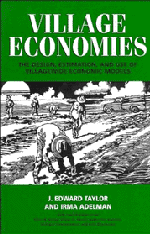Book contents
- Frontmatter
- Contents
- Acknowledgments
- 1 Introduction
- 2 Modeling village economies
- 3 The village economy and tenure security in West Africa: A Senegalese village SAM
- 4 Production and distribution in a dry-land village economy
- 5 Migration and the changing structure of a Mexican village economy
- 6 Economic linkages in a small regional economy: The case of Kutus Region, Kenya
- 7 Household nutrition and economic linkages: A village social accounting matrix for West Java, Indonesia
- 8 The village CGE: Basic model and estimation
- 9 Policy simulations
- 10 Conclusions
- Bibliography
- Index
8 - The village CGE: Basic model and estimation
Published online by Cambridge University Press: 05 June 2012
- Frontmatter
- Contents
- Acknowledgments
- 1 Introduction
- 2 Modeling village economies
- 3 The village economy and tenure security in West Africa: A Senegalese village SAM
- 4 Production and distribution in a dry-land village economy
- 5 Migration and the changing structure of a Mexican village economy
- 6 Economic linkages in a small regional economy: The case of Kutus Region, Kenya
- 7 Household nutrition and economic linkages: A village social accounting matrix for West Java, Indonesia
- 8 The village CGE: Basic model and estimation
- 9 Policy simulations
- 10 Conclusions
- Bibliography
- Index
Summary
This chapter presents the basic village CGE model that we estimate for the Senegalese village of Keur Marie; the Indian, Mexican, and Javan villages; and the Kenyan village-town. After a discussion of the basic village and village-town model, the model structure and parameters are compared across the four villages and village-town. The chapter concludes with a summary of the programming and estimation of the models.
The village CGE
Our village CGEs are rooted in a model of a diversified household-farm economy (or, in the Senegalese case, compound-farm economy) engaged in staple production but also potentially in a portfolio of other income activities. As in the neoclassical household-farm model (Barnum and Squire, 1979; Singh, Squire, and Strauss, 1986), households maximize utility derived from leisure and income obtained by allocating their labor and other factors to production and work activities inside and outside the village.
The village and the households within it are price takers with respect to most goods. Active trade in goods among households is evidence that few households are constrained to be completely self-sufficient. That is, most goods can be considered as tradables at the household level. We refer to such goods as household tradables. These are goods whose prices are determined by markets outside the household, either inside or outside the village. Chapters 3 through 7 document the openness of village economies: A large share of village supplies of goods is “imported” from outside markets, and often a significant part of production is “exported” from the village.
- Type
- Chapter
- Information
- Village EconomiesThe Design, Estimation, and Use of Villagewide Economic Models, pp. 182 - 202Publisher: Cambridge University PressPrint publication year: 1996



